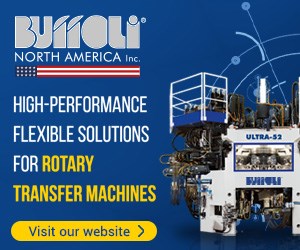Style And Substance
At the Simodec show in France, Wirth & Gruffat (Argonay, France) introduced a new machine called Transturn TT-312. It is designed to combine the advantages of multi-spindle screw machines and rotary transfer technology. The company calls it a manufacturing cell.
At the Simodec show in France, Wirth & Gruffat (Argonay, France) introduced a new machine called Transturn TT-312. It is designed to combine the advantages of multi-spindle screw machines and rotary transfer technology. The company calls it a manufacturing cell.
Built on a rotary transfer platform, the machine has 12 spindles located on an indexable table. Each of the spindles is independently driven by a 10kW motor, and each is capable of up to 6,000 rpm. For thermal stability, each spindle is water cooled. In addition to the rotational speeds for turning, each spindle is capable of full C-axis motion, under the control of the machine's CNC, when drilling or milling operations are specified. A common spindle nose accepts standard collets or three-jaw chuck workholders.
The indexing table uses a triple Hirth coupling system for accurate and repeatable index positioning. Arrangement of the Hirth tooth crown locking and location coupling system does not require the table to lift to index. This design saves time and eliminates possible contamination of the coupling system from chips and coolant.
Indexing of the table is under computer numeric control. It is therefore programmable and can index either one station at a time or multiple stations. This makes for a flexible arrangement whether the shop wants to run the same clamping fixture on each spindle or alternate different workholders. The net result is the ability to machine a single part in sequence or process more than one part at a time.
For applications requiring front and backside machining, the Transturn has sufficient stations to invert or reposition workpieces one or several times in the machining sequence. Each part clamping mechanism has two hydraulic pressures that can be set. High pressure clamps secure thick walled and solid workpieces while a second, lower setting, is available for thin walled parts. For inverting or repositioning workpieces, standard systems or robot manipulators can be used in the machine.
Cutting tools mount on two 2-axis slide sets, one located above the spindle and a second located below. Both slides have 100 mm strokes and operate under a programmable CNC. The slide unit is attached to a vertical support member. This orientation allows chips to fall cleanly away from the tool slide workzone and into a recovery area in the bottom of the machine.
Each slide accepts indexable insert turning tools and static shank tools (drilling, tapping, reaming) using quick-change VDI holders. All stations have through the tool coolant capability. Any of the tool slides can be equipped with power tooling for milling and contouring operations. A minimum of 22 simultaneous machining operations can be programmed on this rotary transfer machine.
Loading of raw stock is by bar feeder with cut-off station. Workpiece blanks can be loaded via an integral robot manipulator or other material handling device.
Transturn uses, as standard, a Siemens 840D CNC. This control is capable of operating up to 60 axes.
For operator access, a six-panel telescoping door allows full access around the periphery of the machine. Wide openings create easy access to each work station. In operation, the enclosure is leak proof against metalworking fluids.
In the United States, Transturn is distributed through TPS International (Sussex, Wisconsin).
Related Content
CAM-Driven Lathe Questions
There can be hidden issues using legacy cam-driven lathes that can be overcome using new CNC technology. Here are three to keep in mind.
Read More5 Tips for Multichannel Programming
Programming for multitasking machines can be complex. Knowing several key points for making the process less challenging can save a programmer time as well as lessen confusion and the risk of error.
Read MoreStuder Universal Cylindrical Grinding Machine Streamlines Performance
Studer’s FavoritCNC universal cylindrical grinding machine has been further developed to feature modern grinding technology with high-precision, simple operation at a cost-effective price point.
Read MorePlanning for Growth Amid Uncertainty
Six strategies to maximize a company’s success amid unpredictability.
Read MoreRead Next
Finding the Right Tools for a Turning Shop
Xcelicut is a startup shop that has grown thanks to the right machines, cutting tools, grants and other resources.
Read MoreHow To (Better) Make a Micrometer
How does an inspection equipment manufacturer organize its factory floor? Join us as we explore the continuous improvement strategies and culture shifts The L.S. Starrett Co. is implementing across the over 500,000 square feet of its Athol, Massachusetts, headquarters.
Read More



















